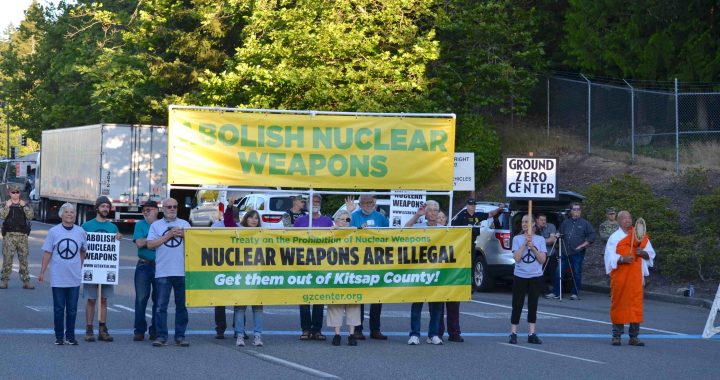The US Navy’s ballistic missile submarines have always had one sole mission (in the Navy’s own words): “strategic deterrence, which is the act of deterring a nuclear attack with a safe, secure, and effective nuclear-deterrent force.” In other words, the belief that another nation will be deterred from using nuclear weapons as long as it believes it will be destroyed (by nuclear weapons) as a consequence. Should deterrence fail, we would end up with what is known as mutually assurred destruction (MAD) and, in the case of a nuclear war with Russia, essentially the end of civilization as we know it.
Each of the US Navy’s deployed OHIO Class “Trident” ballistic missile submarines currently sails the seas loaded with twenty Trident II D5 missiles in its launch tubes. The missiles are loaded with a mix of W76 and W88 thermonuclear warheads. The W76-1 has an effective yield of 100 kilotons, and the W88 has a yield of 455 kilotons. These are known as strategic (as opposed to tactical) nuclear warheads. For comparison, the atomic bomb dropped on Hiroshima was approximately 15 kilotons.
The 2018 Nuclear Posture Review (NPR) recommended “lowering the yield of some existing submarine-launched ballistic missile warheads…” in order “to keep our deterrent effective for our world today.” The government’s idea was to create a tactical nuclear warhead that would be carried on existing submarine launched missiles as a way of countering Russia.
I’m not sure how many drinks the authors of the 2018 NPR had before coming up with this boneheaded idea, but let’s face it – mixing low-yield and high-yield nuclear weapons on the Trident missile is a recipe for disaster, particularly if we ever launch one at an adversary (which would most likely be the Russians).
In September 2018 the Congress provided $65 million for the low-yield warhead as part of an annual spending package in landslide votes in both the House and Senate. The same article reported that, “the funding is a victory for the military, Trump administration and congressional Republicans who believe a smaller warhead that can be fired from submarines will deter Moscow from using its own tactical nuclear weapons.”
An analysis of the ramifications of the use of tactical nuclear weapons is well beyond the scope of this article, but I think it safe to say that if war broke out between NATO and Russia, and even small, tactical, nuclear weapons were introduced (by either side), the results would be beyond imagination – with the likely escalation that would result, besides the millions of lives lost on the European continent, such a conflict would likely break out into the worst-case scenario of a full-scale nuclear war between the US and Russia, and it is safe to say that the survivors would envy the dead.
Production of the new “low-yield” version of the W76-1, known as the W76-2, called for by the Trump administration in 2017, is already underway at the Pantex Plant in Texas, according to the National Nuclear Security Agency.
Assuming that the new Congress does not stop this madness, at some point in 2019 the new low-yield W76-2 warheads will be ready for deployment on some number of Trident II D5 missiles. The assumption would be that a certain number of Trident missiles would be reconfigured to carry only the W76-2, and a certain number of these missiles would be carried on each Trident submarine while on patrol.
The real questions (that no one in the Pentagon seems to be asking) are: What happens when a Trident missile is launched against an adversary (most likely the Russians)? How will that adversary react? There is absolutely no way an adversary can know which warheads are on the missile(s) headed in their direction (if it was a “tactical” versus a “strategic” strike). They would have to assume the worst case scenario, and would most certainly respond with their full nuclear response, resulting in co-annihilation.
The Union of Concerned Scientists (UCS) have published a fact sheet that quotes a number of security experts saying that, “Perhaps the biggest fallacy in the whole argument [for the low-yield warhead] is the mistaken and dangerous belief that a ‘small’ nuclear war would remain small… These so-called ‘low-yield’ nuclear weapons are a gateway to a nuclear catastrophe.”
There are fundamental questions we should ask about the sanity of people who spend their time preparing for nuclear war. That being said, there is no question that the plan to mix low and high-yield warheads on Tridents is categorically INSANE! There is no sound logic in the plan to mix low and high-yield warheads on Trident submarines.
It is not too late to stop production of the W76-2!
Bill have just been reintroduced the new Congress to stop the new warhead. Representative Ted Lieu has introduced H.R. 1086, and Senator Ed Markey has introduced S. 401; both bills “prohibit the research and development, production, and deployment of the Trident D5 low-yield nuclear warhead, and for other purposes.” Both bills introduced in the previous session of Congress were called the “Hold the LYNE Act”; LYNE standing for low yield nuclear explosive.
It will be critical that we, as citizens, get every possible member of Congress to support these bills.




